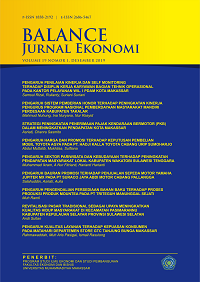Analysis Of Influencing Factors Poverty in East Nusa Tenggara Province 2016 – 2020
DOI: https://doi.org/10.26618/jeb.v19i1.11108
Poverty, IPM, UMK, Manpower, Government Expenditures, and Education Level
Abstract
The destitution rate in the East Nusa Tenggara District overall is still high, still over the public neediness level. This study means to analyze the factors that influence the System/City Destitution Level in the East Nusa Tenggara Locale in 2016-2020. Board information relapse examination is the examination utilized in this review. The free factors utilized in this study were the Human Advancement Record, Area The lowest pay permitted by law, Labor supply, Government Consumptions, and Training Level; while the reliant variable utilized is the Neediness Level. The information utilized is information from 22 rules/urban communities in East Nusa Tenggara Region in 2016-2020. The outcomes showed that the best evaluation model was the Fixed Effect Model (FEM). The model exists, with a coefficient (R2) of 0.998260. Labor and Government Consumptions were found to adversely affect the Destitution Level in the Regime/City of East Nusa Tenggara Territory in 2016-2020, while the Human Improvement File, Locale The lowest pay permitted by law, and Training Level factors affected the Neediness Level.References
A. Kusuma, B. M., & Octastefani, T. (2019). Melawan Budaya Kemiskinan: Strategi Implementasi Perda Penanganan Gepeng Di Daerah Istimewa Yogyakarta. WELFARE : Jurnal Ilmu Kesejahteraan Sosial, 7(1). https://doi.org/10.14421/welfare.2018.071-02
Atalay, R. (2015). The Education and the Human Capital to Get Rid of the Middle-income Trap and to Provide the Economic Development. Procedia - Social and Behavioral Sciences, 174, 969–976. https://doi.org/10.1016/j.sbspro.2015.01.720
Estrada, A. A. E., & Wenagama, I. W. (2020). Pengaruh Laju Pertumbuhan Ekonomi, Indeks Pembangunan Manusia dan Tingkat Pengangguran Terhadap Tingkat Kemiskinan. E-Jurnal Ekonomi Pembangunan Universitas Udayana, 9(2), 233–261.
Kadji, Y. (2012). KEMISKINAN DAN KONSEP TEORITISNYA Oleh. Journal, 1–21.
Maipita, I. (2014). Mengukur Kemiskinan dan Distribusi Pendapatan. 259.
Setiawati, A. K., & Setiawan. (2012). Pemodelan Persentase Penduduk Miskin di Jawa Timur dengan Pendekatan Ekonometrika Panel Spasial. Jurnal Sains dan Seni ITS, 1(1), D183–D187.
Sukmaraga, P. (2011). Analisis Pengaruh Indeks Pembangunan Manusia, PDRB, Per Kapita, Dan Jumlah Pengangguran Terhadap Jumlah Penduduk Miskin Di Provinsi Jawa Tengah. Harvard Business Review, 85(3), 21–22.
Trisnu, C. G. S. P., & Sudiana, I. K. (2019). Pengaruh Pertumbuhan Penduduk, Pengangguran, dan Pendidikan terhadap Tingkat Kemisikinan Kabupaten/Kota Provinsi Bali. E-Jurnal EP Unud, 8(11), 2622–2655.
Yacoub, Y. (2012). Pengaruh Tingkat Pengangguran terhadap Tingkat Kemiskinan Kabupaten / Kota di Provinsi Kalimantan Barat. 8, 176–185.












